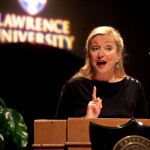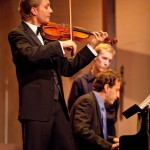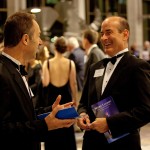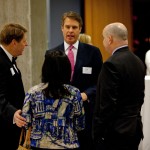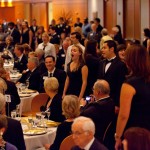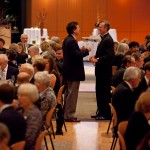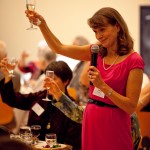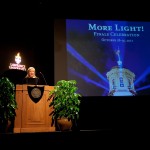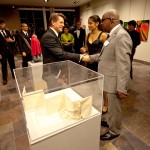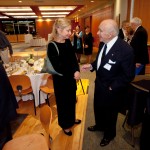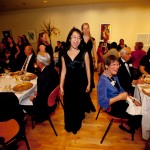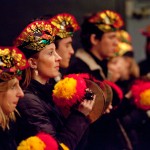Category: More Light! Campaign News
More Light! – $160 million!
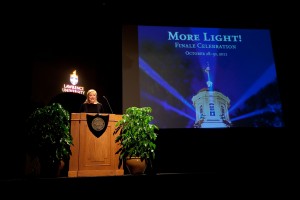 Lawrence University began a weekend-long celebration Friday evening by announcing the college had met and exceeded its More Light! fundraising goals. President Jill Beck delivered the record-setting total …
Lawrence University began a weekend-long celebration Friday evening by announcing the college had met and exceeded its More Light! fundraising goals. President Jill Beck delivered the record-setting total …
(Click on the arrow)
The More Light! campaign began in 2005 with a “quiet phase” and was publicly launched in October 2008 with a goal of $150 million. Its $160 million total more than doubled Lawrence’s last major capital campaign, which ended in 1997 and raised $66.3 million, surpassing its goal of $60 million.
(Click on the arrow)
The campaign finished in a flurry, generating more than $3 million in gifts in the last week to push it over the $160 million mark.
But Harry Jansen Kraemer ’77 was quick to remind Lawrentians that the success of the campaign is not measured in dollars. (Click on the arrow)
Photos From the More Light! Finale Celebration
More Light! Lawrence Collects
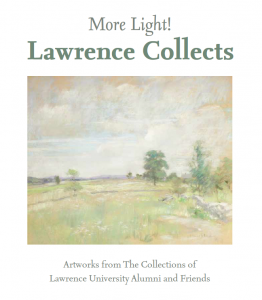 David Hockney. Rembrandt van Rijn. James McNeill Whistler. These are just a few of the renowned artists with whom Lawrence students have the opportunity to become acquainted through courses in art history. Now, thanks to alumni and friends of Lawrence, students can view and reflect upon works by these and other great artists firsthand in the Wriston Art Center galleries as part of the exhibition More Light! Lawrence Collects.
David Hockney. Rembrandt van Rijn. James McNeill Whistler. These are just a few of the renowned artists with whom Lawrence students have the opportunity to become acquainted through courses in art history. Now, thanks to alumni and friends of Lawrence, students can view and reflect upon works by these and other great artists firsthand in the Wriston Art Center galleries as part of the exhibition More Light! Lawrence Collects.
More Light! Lawrence Collects celebrates the conclusion of Lawrence University’s More Light! campaign. The exhibition offers a sample of the art collected (and in a few cases created) by members of the Lawrence community. Their generosity allowed the valuable works from their private collections to travel from near and far to be shared with students, faculty, staff and community members. A special thank you to George Chandler ’51, who permanently gifted a work of art to the college as part of More Light! Lawrence Collects, allowing future generations of Lawrentians to study and enjoy it.
“Light! More Light!” is a fitting motto for a college whose mission is to enlighten its students through a liberal arts education. Exhibitions such as More Light! Lawrence Collects bring the light of additional ideas, techniques and ways of perceiving the world to our campus.
View photos of some of the exhibition works.
This exhibition is currently open to the public and will continue through November 23, 2011.
What Did More Light! Achieve? A Summary
When the More Light! campaign was publicly launched in 2008, there were four major goals:
- Grow the endowment
- Complete necessary, new capital projects without incurring debt
- Further enhance the academic experience for all students
- Bolster the Lawrence Fund (for annual operating expenses.)
Lawrence University, it’s alumni and friends achieved the goals — and then some. Here is a brief summary of the highlights: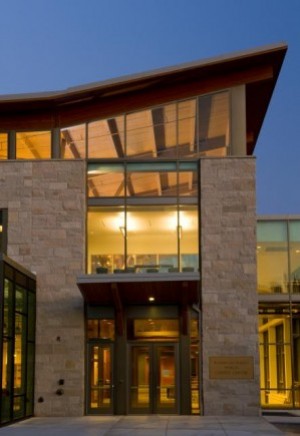
- The opening of the $35 million, 107,000-square-foot Richard and Margot Warch Campus Center, the largest building project in the school’s history. The engineering crown jewel has been recognized with numerous awards, among them LEED Gold Certification by the U.S. Green Building Council. The project was launched with a $16 million gift — the largest in Lawrence history — from an anonymous donor. The Warch Campus Center has become the focal point of campus life with its multiple dining options, meeting space for clubs and organizations, concert venue, art exhibition space and a cinema. It also has enhanced college-community relations, as numerous corporate and community organizations have taken advantage of the campus center’s stunning spaces and amenities for meetings, retreats and training sessions.
- The addition of four endowed professorships, two in the sciences (environmental studies and biology), one in the Conservatory of Music and one in servant leadership. Endowed professorships enable Lawrence to attract and retain the most talented teachers and offer new programs for collaboration and interdisciplinary study.
- The establishment of the Lawrence Fellows Program, which brings scholars who have recently completed their PhD to campus for a two- or three-year appointment. Fellows teach courses, offer individualized instruction opportunities to students and continue their professional activities as scholars and/or performers. Since the program was launched, 35 Fellows have brought the latest research directions from many of the country’s most distinguished graduate programs to Lawrence.
- A 20,000-square-foot expansion of the Bjorklunden lodge on Lawrence’s 425-acre “northern campus” outside Baileys Harbor in Door County. The additional space allowed Lawrence to expand its signature adult summer seminar series course offerings from 24 weekly seminars to 36.
- The establishment of the Senior Experience. A significant capstone curricular project required of all students, the Senior Experience is designed to demonstrate proficiency in the students’ major field of study.
- Commitment to greater diversity, in part through a partnership with the Posse Foundation, Inc. Each year, a culturally diverse cohort of 10 students from New York City public high schools is selected to join Lawrence’s incoming freshman class. Students are selected for the four-year program on the basis of their leadership ability, community engagement and the unique perspectives they bring from one of the world’s most cosmopolitan cities.
- Renovations to the Lawrence Memorial Chapel, Harper Hall and Stansbury Theatre, including new seats in all three venues, state of the art sound system in the chapel, aisle lighting in the chapel and Harper Hall.
- The launch of the Lawrence Scholars programs, which bring alumni to campus for presentations about their particular career field and assist students with connections that could lead to summer internships or jobs after graduation. The program began with a focus on scholars in business and has grown to include alumni programs on arts and entertainment, the environment, film studies, government, international business, law and medicine.
- Enhanced athletic facilities, including a resurfaced track, outdoor batting cages for the baseball and softball facilities, a remodeled weight room, a student-study lounge at
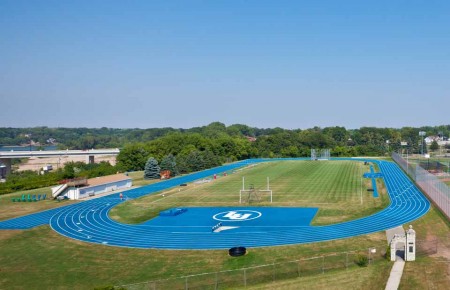 Alexander Gym, complete with computer work stations, a projector system for video analysis and the installation of championship banners in Alexander Gym.
Alexander Gym, complete with computer work stations, a projector system for video analysis and the installation of championship banners in Alexander Gym.
Lawrence University Adds Wind Turbine to Sustainability Efforts
As Lawrence University’s successful More Light! campaign draws to a close, one of its latest initiatives is coming to life in Northeast Wisconsin.
*****
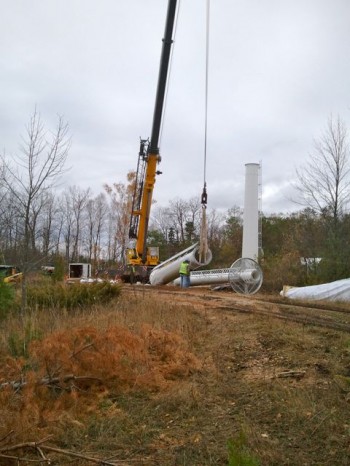
With its vast assortment of cedars, pines, firs and spruce, Lawrence University’s 425-acre northern campus at Björklunden in Door County has never had a problem being green.
In a few days it will be even greener, thanks to college’s first venture into wind energy. A 120-foot tall, 50-kilowatt turbine is being assembled and erected on the estate just south of Baileys Harbor and will be generating electricity by mid-November.
In the next 20 years, the turbine project is expected to convert Door peninsula breezes into enough electricity to cover a third of the electrical needs of the 37,000-square-foot lodge that is home to Björklunden’s summer adult seminar series and student immersion weekends during the academic year. The nearly $370,000 project was funded by private donations and grants from Focus on Energy and Wisconsin Public Service.
“This project is a powerful symbol of our long-term commitment to environmental sustainability, and it will have a substantial impact on our energy use and carbon emissions,” said Jason Brozek, assistant professor of government and current chair of Lawrence’s Green Roots initiative.
The wind turbine at Björklunden is only the latest Lawrence effort to harness alternative energy sources. In August, the college installed its second solar panel, a 20-kilowatt array on the roof of Hiett Hall. Utility company and Focus on Energy grants, along with a manufacturer’s rebate, reduced the panel’s cost by more than $65,000 and reducing the college’s investment payback to six years on a panel with an estimated life span of more than 30 years.
The Hiett Hall panel complements Lawrence’s first solar panel, a 2.92-kilowatt unit on the roof of Youngchild Hall. Installed appropriately on Earth Day, 2010, that panel already has generated more than 4,700 kilowatt hours of electricity while reducing the college’s carbon dioxide production by nearly five tons.
Since launching its Green Roots initiative in 2008, Lawrence has twice been named to the Princeton Review’s list of America’s greenest colleges and was ranked 44th nationally on the 2011 Sierra Club’s cool school rankings of the country’s top green colleges.
Among Lawrence’s sustainability efforts:
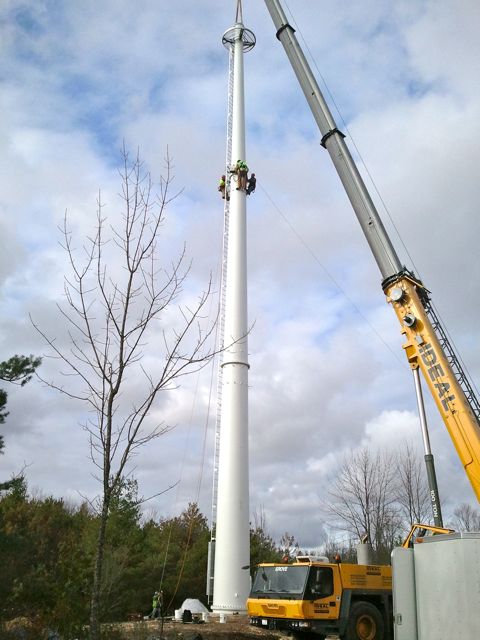
- A five percent reduction in greenhouse gas emissions in the past year — and a 41 percent reduction since 2002 — through energy efficiency changes.
- 100 percent use of recycled paper on campus for photocopying and letterhead.
- 15 percent commitment of campus food is sourced and produced locally (within 100 miles)
- The diversion of 30 tons of kitchen waste to the student-run sustainable garden on campus for composting.
- A total of 12,000 pounds of electronic waste collected and recycled in the campus’ first “e-sweep” last May.
- First-place in the 2011 Upper Midwest Association for Campus Sustainability’s Campus Energy Challenge with an overall energy reduction of 12.86 percent.
- 10th place in the 2011 Recyclemania national recycling competition (per capita category) with an average of 39.15 pounds per person.
“From students and faculty to staff, administration and alumni, we’ve pulled together as a community to make environmental sustainability a priority across the entire campus,” said Brozek.
Bart De Stasio named Singleton Professor in the Biological Sciences
Bart De Stasio, a Lawrence University alumnus and esteemed member of the Biology Department faculty, was recently named the first holder of the Singleton Professorship in the Biological Sciences, the college’s newest endowed professorship. Supported by a $1.5 million gift to the More Light! campaign from Charlot and Dennis Singleton of Atherton, Calif., endowed professorships enable Lawrence to attract and retain faculty who are leaders in their academic fields. And, in the selection of De Stasio for this distinction, the Northeast Wisconsin community also benefits.
*****
Tracking the Invaders: Lawrence University Scientist Monitors Non-native Species in Fox River
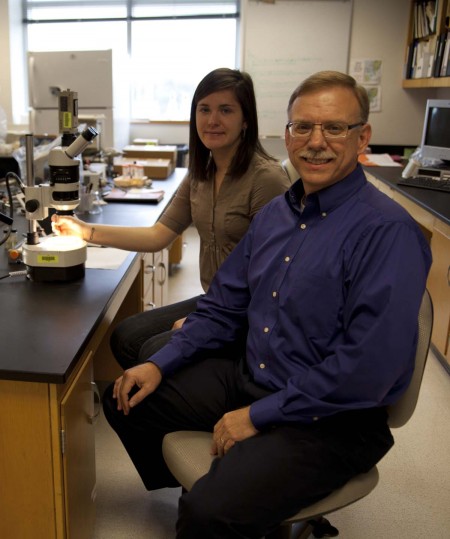
Lawrence University biologist Bart De Stasio is on the hunt. Not for trophy bucks or record-size fish. His targeted prey is invasive species —nickel-sized zebra mussels and six-inch round gobies.
As for his preferred weapon of choice: think giant hot tub.
A specialist in aquatic biology and predator-prey interactions, De Stasio, in collaboration with Lawrence students, is conducting an on-going study of the Fox River, looking for non-native and potentially damaging species that might be making their way up the river from the bay of Green Bay to the upland lakes, including Lake Winnebago.
Working closely with professors outside the classroom on projects such as De Stasio’s invasive species research is regarded by many students as the most enriching experience of their Lawrence education. One of 15 Lawrence students to date who has assisted on the invasive species study, Adam Breseman spent the summer in De Stasio’s lab analyzing water samples, searching for anything from Chinese mystery snails to another invasive fish, the Eurasian Ruffe.
“It was a very intellectually stimulating experience,” said Breseman, a biology major from Baileys Harbor. “Coming into this, I knew very little about zooplankton and benthic invertebrates, but I learned a tremendous amount about those organisms as well as the Fox River watershed system. I’m only a sophomore, so I appreciated the opportunity to work on an internship like this.”
As the process of restoring and reopening the entire 17-lock navigational system between Lake Winnebago and Green Bay moves toward an anticipated 2015 conclusion, De Stasio’s research will be critical in determining whether a proposed boat transfer station at the Rapide Croche lock near Wrightstown is successfully keeping invasive species out of the upper river system.
Started in 2005, De Stasio’s study is collecting data on both species and populations, and is expected to continue for five years after the boatlift becomes operational.
“Right now we’re trying to identify everything, including all of the invertebrates, living at six different locations — three above and three below the site of the proposed boatlift at Rapide Croche lock — and determine whether it is a native or non-native species,” explained De Stasio. “The possibility of transporting something above that lock is a real concern. It would be easy for a zebra mussel attached to a boat’s hull or a spiny water flea on a fishing line to get moved past the barrier.”
Junior Amanda Dwyer from Ralston, Neb., spent 10 weeks this summer dip-netting, beach-seining and working with an Ekman grab on the Fox River, collecting samples for the study.
“It was an awesome experience going out into the field and coming back to the lab to identify what we collected,” said Dwyer, a biology and environmental studies major. “I became more comfortable with the different sampling methods we were taught in class and I learned the distinguishing characteristics of invasive species versus native species we collected. It was great being able to work with Prof. De Stasio on such an extensive and relevant project.”
To limit the possibilities of upstream spread of exotics and in conjunction with his invasive species study, De Stasio has investigated the use of a hot-water treatment to clean boats — and kill any undesirable hitchhikers — before they pass the Rapide Croche lock. Working with a student, Jessica Beyer, De Stasio has determined that for the most probable invasive species, a five-minute minimum immersion in a tank of 110-degree water would essentially kill any of the invasive species they’ve identified.
“Basically, any boat moving up the river would get dunked in a giant hot water tub that could accommodate boats as large as 53-feet in length,” said De Stasio. “Other parts of the boat, the livewell, bilge and motor, would be hosed down with the hot water as well. This is ecologically preferable to a chemical scrub because you don’t have to deal with any potentially toxic waste issues.”
While the hot-water dunk treatment is expected to prevent invasive species from breaching the Rapid Croche lock, it can’t completely eliminate the possibility of non-native species penetrating the upper river.
Boats taken out of Green Bay or the Fox River below the Rapid Croche lock and relaunched upstream can wind up introducing invasive species beyond the barrier. Educating boaters of this danger will be critical to the success of limiting the number of unwanted species.
“An education program created by Phil Moy from the UW Sea Grant Program is designed to raise boaters’ awareness about the importance of not transporting their boats from one body of water to another without a significant waiting period to allow the boat to completely dry,” said De Stasio. “Five days is the recommended wait time but longer than that would be even better. It’s going to take a concerted effort by all users to keep the Fox River and other upland bodies of water from being invaded with non-native species. While no plan is fail safe, it’s easier to keep them out than it is to control them once they establish themselves.”
